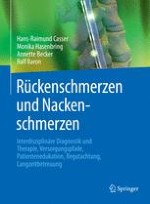Zusammenfassung
Nackenschmerzen sind oft eine stark beeinträchtigende und rezidivierende Störung, die von Phasen der Remission und Exazerbation charakterisiert ist. Es ist evident, dass Schmerz oder eine Verletzung initiale Trigger für Veränderungen der neuromuskulären Kontrolle sein können – Veränderungen, die auch jenseits der akuten Schmerzphase erhalten bleiben und zum Wiederauftreten der Symptome beitragen können. Zudem haben Studien gezeigt, dass sich die veränderte Muskelaktivität trotz Abmilderung der Symptome nicht automatisch mit der Zeit zurückbildet. Das unterstreicht den Bedarf für eine hochwertige und spezifische Rehabilitation, insbesondere wenn die veränderten Muskelaktivitätsmuster weniger effiziente Kombinationen von Muskelsynergien beinhalten, was die Anfälligkeit der zervikalen Region für Verspannungen und weiteren Schmerz erhöht. – Das Kapitel »Nackenschmerzen und sensomotorische Kontrolle« untersucht Studienergebnisse, die Änderungen der zervikalen sensomotorischen Kontrolle bei Patienten mit Nackenschmerzen beschreiben, und hebt die Bedeutung dieser Erkenntnisse für die Behandlung von Halswirbelsäulenstörungen hervor.
